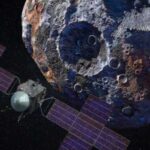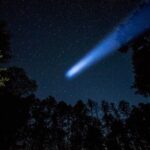NASA to Grow Plants on Moon for the First Time
The post NASA to Grow Plants on Moon for the First Time appeared first on Healthy Holistic Living.
In an unprecedented leap for lunar exploration, NASA’s Artemis III mission is poised to revolutionize our understanding of extraterrestrial agriculture. Scheduled for 2026, this groundbreaking expedition will witness humanity’s triumphant return to the moon’s surface, nearly five decades since the last Apollo landing in 1972.
At the forefront of this historic endeavor is the Lunar Effects on Agricultural Flora (LEAF) experiment, meticulously crafted to unravel the mysteries of plant growth in the harsh lunar environment. Astronauts will undertake the monumental task of nurturing plants on the moon’s barren landscape, meticulously documenting their response to reduced gravity and cosmic radiation, while monitoring their vital processes such as photosynthesis and growth.
While spacefarers have cultivated vegetables aboard the International Space Station for over a decade, and China’s Chang’e 4 mission briefly witnessed seed germination on the lunar surface in 2019, LEAF represents a quantum leap forward. Unlike previous endeavors, LEAF holds the promise of unraveling the complete life cycle of plants on the moon, shedding light on the feasibility of sustaining life beyond Earth’s confines.
All About LEAF Experiment
The first of the scientific endeavours aboard Artemis III is the Lunar Effects on Agricultural Flora (LEAF) experiment, a crucial study aimed at understanding plant life in a lunar environment. This experiment will involve astronauts actively growing plants on the moon’s surface, marking a significant step in extraterrestrial agriculture. By monitoring the plants’ ability to photosynthesize and adapt to the moon’s unique conditions of lower gravity and heightened space radiation, researchers hope to glean insights into how plant life could sustain future explorers.
Past endeavors have laid the groundwork for this ambitious project. For instance, astronauts have been cultivating vegetables on the International Space Station for over a decade, learning how plants respond in microgravity environments. Furthermore, China’s Chang’e 4 mission previously initiated the lunar plant growth experiment by sprouting seeds on the moon in 2019. Although these seeds survived only briefly, they represented the first instance of biological matter growing on the moon, setting the stage for more advanced experiments like LEAF.
With the LEAF experiment, NASA aims to observe the full growth cycle of plants on the moon for the first time. Success in this endeavor could pave the way for using plants not only as a sustainable food source but also as a natural life-support system, producing oxygen and removing carbon dioxide, thus contributing to the feasibility of long-term lunar colonization.
The Artemis III Mission: A New Era of Lunar Exploration
The Artemis III mission represents a monumental step in NASA’s renewed lunar exploration efforts. Scheduled for 2026, this mission not only aims to return humans to the moon for the first time since the Apollo 17 mission in 1972 but also to establish a framework for future sustained lunar presence. Artemis III will see astronauts landing near the moon’s south pole, an area unexplored by previous manned missions and believed to contain frozen water and other vital resources.
Central to the mission’s success are the astronauts themselves, who will be tasked with conducting a series of complex experiments and demonstrations on the lunar surface. These activities are designed to test new technologies and gather critical data to inform future long-term stays on the moon and eventually Mars. This includes setting up and utilizing the equipment brought along for the LEAF, LEMS, and LDA experiments.
Furthermore, Artemis III serves as a test bed for NASA’s Gateway, a lunar orbit space station that will provide vital support for a sustainable human return to the moon. The Gateway will offer a staging point for lunar landings, help facilitate remote operations on the lunar surface, and provide living quarters for astronauts before their descent to the moon or their journey back to Earth. This approach not only enhances the feasibility of prolonged lunar missions but also reduces the risks associated with direct landings and takeoffs from the lunar surface.
In addition to establishing technological and scientific benchmarks, Artemis III aims to foster international collaboration and inclusivity in space exploration. NASA is partnering with several international space agencies to share knowledge, resources, and manpower. This collaborative effort underscores the mission’s global significance, promoting a unified approach to exploring and utilizing extraterrestrial environments for the benefit of all humanity. These partnerships are essential in developing the interoperable systems that will support a network of activities on the moon, setting the stage for the future exploration of Mars and beyond.
Monitoring the Unseen: The Lunar Environment Monitoring Station (LEMS)
The Artemis III mission also includes the Lunar Environment Monitoring Station (LEMS), an advanced seismometer designed to delve into the mysteries of lunar geology. Positioned near the moon’s south pole, LEMS will play a critical role in detecting and analyzing moonquakes. Understanding these seismic activities is not merely an academic pursuit; it has practical implications for constructing stable lunar bases in the future. By characterizing how the ground moves during these quakes, scientists can better understand the underground structures and assess the stability of the lunar soil for building and living.
The placement of LEMS in the lunar south pole is strategic, given the area’s significance in terms of scientific interest and potential human colonization. This region of the moon is believed to harbor water ice in its permanently shadowed craters, which could be vital for astronaut survival and as a resource for making rocket fuel. The data collected by LEMS will therefore not only help in mapping the moon’s interior but also aid in planning where to establish permanent bases that could utilize these natural resources.
The broader implications of LEMS extend beyond immediate lunar exploration. By providing a clearer picture of lunar geology, the experiment enhances our understanding of the moon’s formation and its evolutionary history. This insight is invaluable, as it also offers clues about the Earth’s early years and the processes that might be common to other celestial bodies in our solar system. With each vibration recorded, LEMS will add to our knowledge base, helping to ensure that future lunar constructions are both safe and sustainable.
Exploring Lunar Conductivity: The Lunar Dielectric Analyzer (LDA)
The third integral instrument of the Artemis III mission is the Lunar Dielectric Analyzer (LDA). This sophisticated device is engineered to measure the electrical properties of the lunar soil, a key factor in the search for water ice and understanding the moon’s environmental conditions. The LDA’s primary function is to analyze how electrically conductive the lunar soil becomes when ice is bound to dust particles, an occurrence particularly expected in the shadowed regions of lunar poles where sunlight does not reach and temperatures plummet.
Understanding soil conductivity on the moon is crucial because it directly impacts the ability to locate and extract water ice. Water ice not only promises a potential drinking source for astronauts but also a critical component for creating fuel and sustaining life support systems. By measuring changes in the soil’s conductivity as the sun rises and sets, the LDA provides essential data that can guide the extraction of these resources, informing where and how to mine the ice while assessing the environmental impact of such activities.
Moreover, the insights gained from the LDA will help scientists refine models of the lunar surface’s behavior under different thermal and sunlight conditions. This knowledge is vital for the design and deployment of future lunar equipment and habitats, ensuring that they operate efficiently in the moon’s challenging environment. The deployment of the LDA, along with the data it will collect, supports the broader goals of the Artemis program by enhancing our understanding of the moon’s properties and paving the way for sustainable human presence and exploration.
Harnessing Lunar Resources: The Quest for Water Ice
The Artemis III mission isn’t just about conducting scientific experiments; it’s also about harnessing the moon’s potential resources, particularly water ice. This section of the mission focuses on identifying and extracting lunar water ice, crucial for both sustaining life and fueling future space exploration. The presence of water ice at the lunar poles, as hypothesized and partially confirmed by previous missions, represents a potential treasure trove of resources.
Extracting water from the lunar soil would enable the production of drinking water and breathable air for astronauts, drastically reducing the need to transport these vital resources from Earth. More intriguingly, lunar water can be split into hydrogen and oxygen, key components for rocket fuel. This capability would transform the moon into a strategic pit stop or even a launchpad for missions further into the solar system, such as to Mars or beyond.
The efforts to locate and mine water ice will involve a combination of remote sensing from orbit, on-the-ground prospecting, and possibly the deployment of autonomous robots or drills. These technologies will not only aid in the immediate extraction processes but will also serve as a preliminary testbed for similar systems that could be deployed on Mars. By turning the moon into both a laboratory and a resource hub, Artemis III paves the way for a new era of extended space exploration.
Technological Innovations and Experimentation: Enhancing Lunar Exploration Tools
The technological advancements that underpin the Artemis III mission are pivotal in setting the stage for sustainable lunar exploration and habitation. This section explores the innovative tools and experimental approaches that are being developed to support the mission’s objectives:
Advanced Robotics:
Robotic Arms and Rovers: The deployment of sophisticated robotic systems designed to assist in experiments and handle hazardous tasks that would be risky for astronauts.
Autonomous Navigation: Leveraging artificial intelligence to enable rovers and drones to navigate the unpredictable lunar terrain autonomously, enhancing exploration capabilities.
Communication Systems:
Lunar Satellites: Establishing a network of satellites around the moon to ensure reliable communication between the lunar surface, orbiting spacecraft, and Earth.
Real-time Data Transmission: Developing high-bandwidth communication technologies to allow real-time data and video streaming, crucial for mission control and public engagement.
Habitat Technology:
Expandable Habitats: Testing expandable habitat modules that can be compact during transit but provide spacious living and working areas once deployed on the lunar surface.
Life Support Systems: Innovating closed-loop life support systems that recycle air and water, vital for long-term stays on the moon.
Energy Solutions:
Solar Power Arrays: Utilizing foldable solar panels to generate power efficiently, accounting for the long lunar nights and variable solar exposure at different sites.
Nuclear Power Systems: Exploring the use of small, safe nuclear reactors as an alternative power source to provide continuous energy, especially in shadowed regions where solar power is less feasible.
These technological innovations are not just about making the Artemis missions successful; they are about testing and refining the technologies that will one day support human settlements on the moon and possibly Mars. Each experiment and tool developed for Artemis III has the potential to revolutionize how we live and work in space, bringing us one step closer to becoming a multi-planetary species.
Envisioning the Future of Space Exploration
As the Artemis III mission sets the stage for the next era of lunar exploration, it also frames a broader vision for human activity beyond Earth. This initiative is not merely about setting foot on another celestial body but about establishing a sustainable presence that will enable further exploration of the solar system. The technological advancements, scientific experiments, and strategies for resource utilization developed through Artemis III will provide the necessary groundwork for these ambitious goals, bridging the gap between exploratory missions and permanent settlements.
The implications of a successful Artemis III mission extend far beyond the moon itself. By creating a blueprint for living on another planet, NASA and its international partners are paving the way for the first human missions to Mars. The lessons learned from growing plants in lunar soil, managing resources in a closed environment, and building infrastructure in space will be invaluable for these future endeavors. Moreover, the mission will inspire generations, fueling interest in STEM careers and reinforcing the importance of space in our global culture and consciousness.
In conclusion, Artemis III represents a pivotal moment in space exploration, one that will likely shape the future of humanity’s presence in space. By committing to this path, we are not only chasing scientific knowledge but also fostering a future where Earth is no longer the limit. As we look forward to the results of Artemis III, we remain hopeful and excited about the new horizons that will unfold as we reach for the stars.
The post NASA to Grow Plants on Moon for the First Time appeared first on Healthy Holistic Living.












